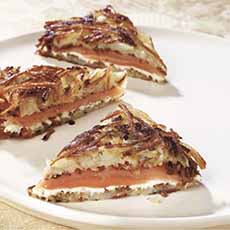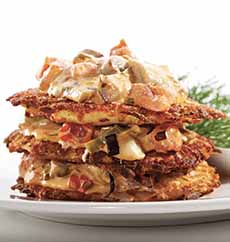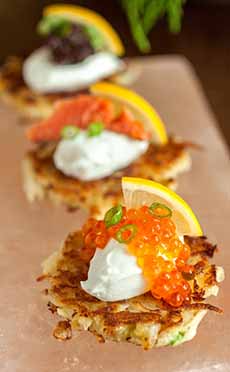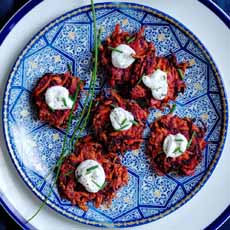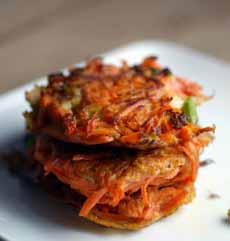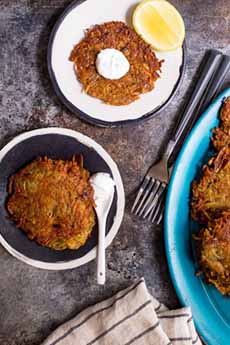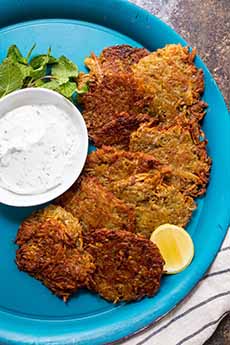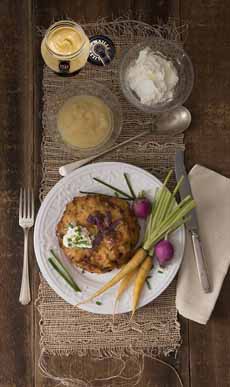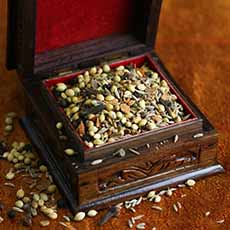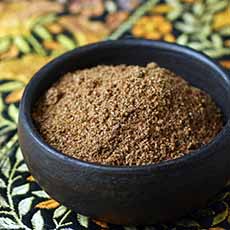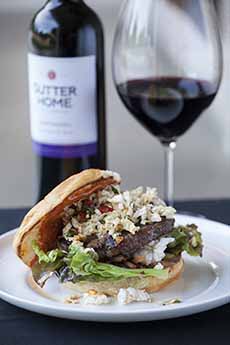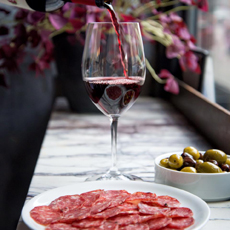|
World Pear Day is December 8th. The history of pears is below.
Pears are one of the few fruits that don’t ripen successfully on the tree. They’re picked when they have reached full size, but before the onset of ripening.
It sounds simple: To test if a pear is ripe, apply gentle pressure to the neck area (photo #1). If it gives slightly, it’s most likely ready to be eaten.
The operant words are most likely. Every so often, you’ll get a pear that simply does not obey the taste test.
We love a juicy pear; so back in August, we purchased three Anjou pears and left them on the countertop to ripen. Three weeks later they were still as hard as rocks.
At that point you’d think that we’d have tried the brown paper bag technique, enclosing the pears in the bag to let its ethylene speed up the ripening.
But no, we were as stubborn as the pears.
In the fourth week, we detected some softness around the neck. Yay!
We washed one of the pears and bit into it. Booo!
It was mostly hard, with the lack of sweetness found in unripe fruit.
HOW TO SALVAGE A NOT-YET-RIPE PEAR
We peeled and sliced the pear, placed it in a bowl, sprinkled it with some Splenda (sparing the sugar calories), and microwaved it for 90 seconds. Close enough.
The second and third pears we cored, peeled, and baked (the recipe is below). The baked pears can be:
Eaten plain, like baked apples (sprinkle the core well with cinnamon sugar). Optional: caramel sauce!
Served with a scoop of sorbet or ice cream.
Puréed into a sauce for grilled chicken or pork, or for pound cake.
Chopped or puréed and added to plain or vanilla yogurt.
Used to make a Pear Martini or other cocktail, or to stir into club soda.
Peeling is a must! Unlike apple skins, pear skins can toughen up under heat. So peel them before you cook them.
Prevent browning! As with apples, you can prevent browning by dipping cut pears in acidulated water (water mixed with a little lemon juice or vinegar). This works with European and American pear varieties, but not with crisp-fleshed Asian pears.
MORE WAYS TO ENJOY PEARS
Pears and apples are close cousins, so you can substitute them in any recipe that calls for apples.
The seasonings are the same, too: cinnamon, clove, ginger, and nutmeg.
How about:
Poached pears, using fruit juice, syrup, wine, or water
Desserts: cakes, pies, tarts
Condiments: chutneys, jams, preserves
RECIPE: EASY BAKED PEARS
Ingredients
Pears
Sugar or other sweetener
Cinnamon
Preparation
1. PREHEAT the oven to 350°F. Peel the pears, slice them in half and scoop out the core with a melon baller. Place face up on a baking sheet.
2. SPRINKLE the core well with (as you prefer), sugar, cinnamon, honey, and chopped nuts. We sprinkle the well with cinnamon sugar, then drizzle the top with honey and sprinkle with the nuts. For a diet version, a simple Splenda/cinnamon seasoning is also delicious.
3. BAKE for 30 minutes; then set aside until cool enough to eat, or let cool completely.
THE HISTORY OF PEARS
The pear tree is a medium-sized tree that grows in mildly temperate regions worldwide (photo #4).
It’s a member of the Rosaceae family, also known as the rose family. Roses are members, of course, but so are popular edibles such as almonds, apples, berries, loquats, pears, quince, and stone fruits.
According to USA Pears, some 3,000 varieties of pears are cultivated worldwide.
Consumers enjoy them as hand fruit, cooked, canned, or juice; they can be pickled or dried; they can be made into perry (the pear version of hard cider), liqueur, or other spirits.
How Long Has Mankind Been Eating Pears
The genus Pyrus, representing all pears, is thought to have originated in present-day Western China.
From there it spread north, south, east, and west, evolving into what became a diverse group of some 30 species.
In Europe, there is evidence of pear consumption since prehistoric times. Many traces of pears have been found in a prehistoric excavation around Lake Zurich.
Those were wild pears, small and round. The pears we know today are the result of millennia of selective breeding.
Pears were cultivated in China as early as 2000 B.C.E.
Pears were also cultivated by the Romans, who ate the fruits raw and cooked, just like apples.
Pliny The Elder’s “Natural History,” published in 77 C.E., noted three dozen varieties. He recommended stewing pears with honey.
The Roman cookbook “De re coquinaria” (the first extant cookbook, written in the 4th or 5th century C.E.) features a recipe for a spiced, stewed pear dish.
|
|

[1] A pear can be rosy, but not yet ripe (photo © Melissa’s Produce | Facebook).
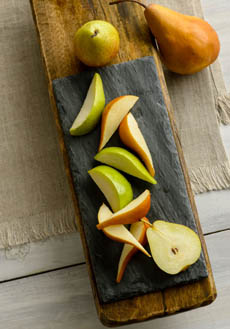
[2] Sliced pears are a finger-food snack. Add them to green salads for a sweet note (photos #2 and #3 © USA Pears).

[3] Have a pear tasting: Gather different varieties and compare.

[4] Pear blossoms: Green buds become white as the weather warms, sometimes a month into spring (photo © Guy Levert | Unsplash).

[5] An Anjou pear grows on a tree (photo © Christian Holzinger | Unsplash).
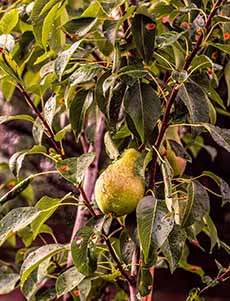
[6] A Forelle pear waiting to be picked (photo © Bram Neus | Unsplash).
|
The Name “Pear”
The word pear likely derives from the Germanic pera, from the Vulgar Latin pira. Go back further, before ancient Greek to the Semitic languages, and you’ll find the word pirâ, meaning fruit.
Pera led to poire in French, peer in Dutch, pera in Spanish and Italian, paere in Danish, paron in Swedish.
In Spanish, “Esto es la pera,” translated to “This is the pear,” refers to a particularly wonderful or enjoyable situation or experience.
The adjective pyriform or piriform means pear-shaped.
Pears In Europe
The European pear is believed to have originated in the general region of the southern Caucasus and northeastern Anatoli, as did the apple.
It has grown there since prehistoric times. Dried slices of pear have been unearthed in Swiss cave dwellings from the Ice Age.
The first Western mention of the pear is found in Homer’s “The Odyssey,” written in the 9th century B.C.E.
Around 300 B.C.E. the Greek writer Theophrastus wrote about the cultivation of pears. Two centuries later, in Rome, Pliny the Elder described 41 varieties.
The Romans ate pears, like apples, both raw and cooked: poached in wine, conserved in grape syrup, and dried for winter consumption.
The less attractive fruits were made into perry (pear cider), or into pear vinegar or pear liquamen, a vegetarian alternative to garum, the popular fish sauce condiment.
The Byzantines served pears in jelly, pear preserves, and pears cooked in wine or in oxymel, a syrup of honey and vinegar.
The Romans spread pear cultivation throughout Europe.
Pears were prized for dessert, both cooked and raw. They were a favorite fruit of Louis XIV (1643-1715). In the 17th century pear growing in France was at its height and many new varieties were developed.
Henry III of England ((1207-1272) received gifts of pears from La Rochelle-Normande in northwest France. They were presented to the king by the sheriffs of the City of London [source].
There are no native American pears. Pears were introduced to America in 1629 when the Massachusetts Company ordered pear seeds from England.
Because of its unique growing conditions, American pears became even more diverse than their European ancestors. Many good, purely American strains were developed, including Bartlett and Seckel cultivars.
In New England during the 19th century, an extraordinary degree of enthusiasm for pears developed—so remarkable that it earned the name ‘“Pearmania*” [source: Oxford Companion to Food, Alan Davidson [Oxford University Press: Oxford] 1999 (p. 590)].
Pears In Asia
Asian pears are different from European pears: uniform in color (yellowish-tan) and shaped more like apples. They have a completely different texture and taste: crisp, grainy, crunchy flesh and do not get succulently juicy and sweet like Western varieties.
They are not generally baked or made into jams because they have high water content; but are commonly served raw and peeled.
In Asia, the cultivation of pears goes back some 2,500–3,000 years and has been chronicled in Chinese writings from at least 1,200 years ago.
Along with the peach and apricot, the pear was long considered a delicacy, enjoyed by the wealthy.
In Japan, the earliest evidence of pears is much later, around 200–300 C.E. But in 1860, near the end of the Edo period, more than 150 cultivars had been recorded and pear was widely planted [source: Oxford Companion to Food, Alan Davidson [Oxford University Press: Oxford] 1999 (p. 590)].
East or West, the original wild pear varieties have been developed into what are now nearly 3,000 varieties worldwide.
________________
*Throughout history, pears have been food for the wealthier classes. They were cultivated in great estates and relished by nobles throughout Europe. New England’s “Pearmania” (circa 1820-1870) was a pastime of the upper class. Gentlemen farmers vied to produce the most luscious specimens of fine pears. Their prized pears were not for sale; they were for family and honored guests.
Men savored the pears in the library as an occasion for male bonding and connoisseurship—much as in later periods they played golf and smoked cigars.
It is interesting to note that New England cookbooks published during this period contain very few pear recipes. Stewed pears and pear tarts are the norms. One might infer that pears were not plentiful among the middle class.
Once California started shipping tons of fruit by rail car to the east in the late 19th century, pears were more plentiful and interest in the pear as a status symbol diminished [source: Oxford Encyclopedia of Food and Drink in America, Andrew F. Smith editor in chief [Oxford University Press: New York] 2004, Volume 1 (p. 530)].
CHECK OUT WHAT’S HAPPENING ON OUR HOME PAGE, THENIBBLE.COM.
|
